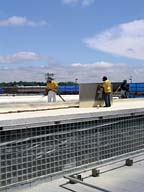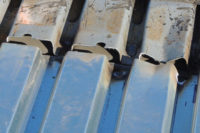
Replacing a roof that was purposely designed to hold water presents a unique set of difficulties-especially when numerous penetrations, multiple tenants, access problems and the desire to quickly cover several hundred squares without any disruptions are added to the mix. The Internet Park building is on Long Island. Winning the bid for this 1.4-million-square-foot job was a real coup for Hygrade Insulators of Phillipsburg, N.J., which had the experience, crews and equipment to perform well.
The company is now finishing up the second phase of this three-phase, high-profile project, which has tenants like The New York Times, Allstate Insurance and LA Fitness. Even the United Nations used it in the 1960s. Planning and efficiency on the part of Hygrade crews allowed them to keep the tenants happy by applying as much roofing in 30 days as some companies do all year.

A Place for Fish to Swim
The building dates back to World War II when the Sperry Corp. used it to manufacture airplane instruments. The reason for the dead slope and high parapets was to contain up to 20 inches of water so that this critical war factory would appear from above to be a fish hatchery. The building was never bombed, but the approximately 40-year-old built-up roof had reached its service limit after long periods underwater."That's not exactly a good thing for a roofer because every time it rained, there was ponding," says Sal Piccione, vice president of the union shop since its founding in 1977. "It was built to hold water and it did."
The building, parts of which had a torch-down modified bitumen installed only a few years earlier, was inspected by John Barry, a local roof consultant. The project was sent out for competitive bidding and specified the use of a spray foam roof. Hygrade won the job even though it wasn't the low bidder. Piccione believes that it was the company's reputation, product and capacity that made the difference.
"They went and looked at some of our work and talked to our customers," he says, adding that the 15-year non-pro-rated warranty backed by a Fortune 100 company helped seal the deal. "It carries a lot of weight. It gets us a lot of work."
Infrared scans showed numerous sections of wet roofing to be removed down to the precast concrete deck. After an asphalt primer, around 200,000 square feet received a torch down modified bitumen and then the GE Silicone Polyurethane Foam membrane was applied over everything. The first of three phases was installed last April when the crew completed 430,000 square feet in 30 working days.
Piccione, who occasionally operated a sprayer throughout the application, believes that his system introduced slope into the building for the first time. The slope would be accomplished through the timing of the application and was continually measured as the foam expanded 30 times the volume of its liquid components. The minimum thickness was 3 3/4 inches of foam, giving the building an R-24 rating, which is the building code for Long Island. Subcontractors replaced about 300 aging drains, some of which were severely clogged.
During peak application periods as many as three Gusmer machines were going at once, each with a sprayer and hose handler. A man on the ground maintained all three machines. Two Gusmer H-20/35's and a new, modified H-50/60 were deployed this summer to gain even greater productivity. To keep up, Hygrade has a holding truck into which the company empties the drums of raw material. "The speed of the process...that's what they were really interested in," says Piccione. "It was also a great convenience for the clients."
Innovative Machinery
What was not so convenient for the contractor was access to all sections of the roof and the company had to run hose as long as 500 feet from the machine. Since the H-50/60 Gusmer machine is capable of spraying up to 60 pounds per minute, heating large amounts of material so that it's still around 120 degrees F when it emerges 500 feet away was a challenge. Piccione took the machines to Gusmer, which upgraded the heated hoses and couplings while installing an innovative hybrid heater in the unit."The one that he got is the first machine," says Bill Hrynkiewicz, director of sales for Gusmer Corp. in Lakewood, N.J. "In fact, he brought some of his other machines here to be retrofitted...It's phenomenal with the progress he's made."
The innovation now has a patent pending and will be offered in select units. A thermal coupler at the end of the heated hose sends a signal to the unit to maintain the temperature. The higher outputs are a vast improvement over the standard 38-pounds-per minute machines.
SPF systems aren't just patch jobs or quick fixes designed to prolong the inevitable. Lengthy warranties and service agreements are attracting large industrial jobs that justify the investment of a high volume machine. In today's business environment so focused on time, speed of installation carries a premium that only the top machines can address. It also is helpful to fully exploit the times when the weather is cooperating and the crews are humming along.
"When you do have your good days, you can maximize your productivity," Hrynkiewicz says. "When doing large roofs, you can apply a good quality roof almost as fast as you can move."
That efficiency reduces labors costs and makes the expensive SPF material much more competitive. Piccione says he's been getting 40,000 to 45,000 square feet installed each workday. The final phase will be conducted next year. All roofs come with the 15-year warranty, of which Hygrade is responsible for any labor during the first half of the warranty, including tear-off. That keeps everyone on the hook, minimizes callbacks and garners Hygrade recognition awards from its foam suppliers GE Silicones and Dow Chemical. About 85 percent of the company's business is polyurethane foam, with the rest being EPDM, BUR and some metal roofing.
Piccione has seen the product evolve from a niche solution to a mainstream product, pointing out that the SPF was recently included in NRCA's venerable Roofing and Waterproofing Manual. He adds that some architects are recognizing the longevity of the product, particularly after seam failures with certain single plies. "We're doing a lot more new construction lately," he says. "The spray foam is just a much more friendly roof system."
Piccione expects to install close to half a million square feet before summer is over; his crews finished 215,000 square feet in just 11 days. The third and final phase will be tackled next spring. In the meantime, he's getting positive feedback from both client and workers. "There are people who worked for Sperry," he says, "They knew where we worked because when it rained, it didn't leak."

Report Abusive Comment